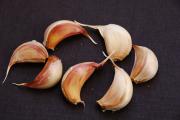Planting and harvest times
Table 1 shows the main times for planting and harvesting for the Perth area. For the hard-necked varieties, bulb size increases as the growing period lengthens. However, planting in high temperatures may retard bulb formation and increase water requirements. With Italian Pink, crops planted before February may mature in September and need a shed for drying. Late plantings result in smaller bulbs.
Table 1 Main planting and harvest times for the Perth area
| Variety | Time of planting | Harvest |
|---|---|---|
| Italian Pink | Mid-February to mid-April | September to November |
| New Zealand Purple | March | Early November |
| Italian White | March to mid-April | Late November |
| California Early | March | December |
| California Late | April/May | December/January |
Planting

Obtaining planting material for garlic can be difficult as there are few growers in Western Australia. The potential grower should approach an existing grower willing to supply good bulbs.
Planting material from Western Australian growers can be purchased from the sale floors at Market City, Canning Vale, from spring to autumn.
Planting imported garlic is not permitted in Western Australia under quarantine regulations because of the risk of spreading introduced diseases. Anyhow, garlic imported from overseas is fumigated and will not grow well.
If importing planting material from interstate, then quarantine requirements need to be met involving plant material treatments and inspections. Importers of small consignments unsure of requirements may contact Quarantine WA on +61 (0)8 9334 1800 for information.
Store planting material as whole bulbs. Garlic can be hung in bunches in a ventilated shed over summer, but it is preferable to store at 10°C. In cool storage, temperatures must not be below 5°C or above 18°C. Just before planting, separate the bulbs into cloves by hand or using compressed air. A mechanical tyre-type cracker, converging flat belts or separator with rubber rollers of decreasing sizes can speed up clove separation.
The cloves can be sorted by hand or mechanically through rubber covered rollers or a drum grader. Grading assists mechanical planting, separates smaller cloves and allows the largest to be planted first.
Select cloves of the correct size and colour that are free of pests and diseases. Small cloves will produce smaller bulbs than larger cloves and can, depending on the variety, be discarded. When bulking up a variety it may be necessary to plant all cloves, including bulbils.
Plant by hand or machine. Use cloves that do not have green shoots. Orientation of cloves by machine is not important, provided that the cloves are not planted upside down. This will reduce yields and make digging difficult.
Types of planters
- Halls seeders have a drum with vanes that pick up the cloves.
- Trickle seeders use a belt passing under a hopper to feed the cloves out in a stream.
- Cup seeders collect the various sized cloves into cups of different sizes.
- Cloves are fed by hand from a hopper down a tube to a seeding wheel or tine which is slow but accurate.
Cloves larger than 5g are ideal for planting, but smaller ones weighing 2–5g can also be used. As a guide, the amount of cloves recommended for planting 1 hectare, based on 320 000 cloves per hectare (32 cloves per square metre) and a bulb size of 50g is:
- up to 2t/ha for a variety with eight cloves per bulb
- 1.3t/ha for a variety with 12 cloves per bulb
- 0.5-1.0t/ha for a variety with 20 cloves per bulb.
Plant garlic 2.5‑4cm deep in rows 25‑30cm apart. Within rows, plant 8‑10cm apart, to give a population of about 40 cloves/m2. After allowing for tractor paths this layout uses 320 000 cloves per hectare. Increasing the clove density to 60/m2 increases yields but reduces bulb size and increases cleaning time.
